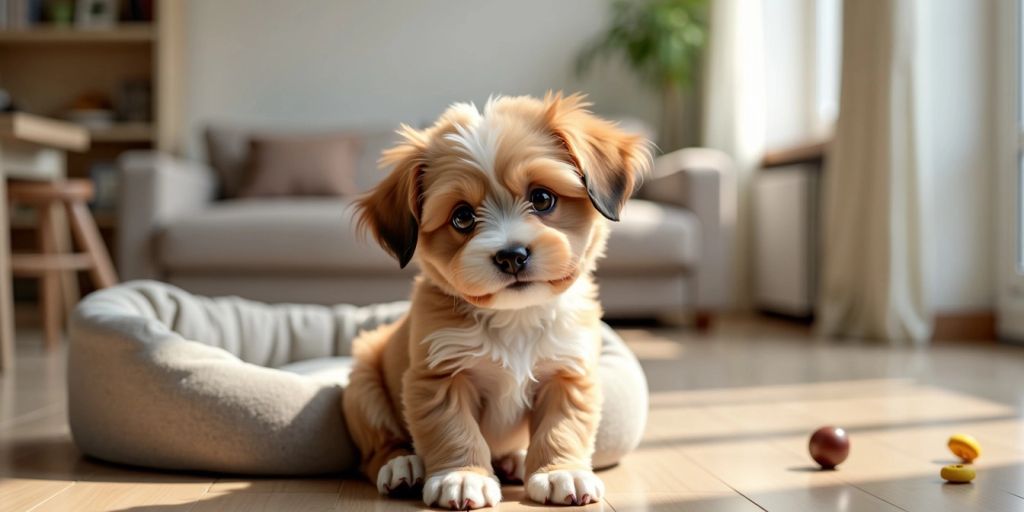Housebreaking a puppy can seem like a huge task, but with the right approach, it becomes manageable and even enjoyable. This guide is designed to help new pet owners understand the essentials of housebreaking, from recognizing your puppy's bathroom needs to using positive reinforcement techniques. With patience and consistency, you can set the foundation for a well-trained and happy dog.
Key Takeaways
- Consistency is crucial in housebreaking a puppy; stick to a regular routine for feeding and bathroom breaks.
- Positive reinforcement, such as treats and praise, is more effective than punishment in training your puppy.
- Recognize the signs that your puppy needs to go, like sniffing or circling, to prevent accidents.
- Accidents will happen; handle them calmly and use them as learning opportunities for your puppy.
- Using the right tools, like a suitable crate and cleaning supplies, can make the housebreaking process smoother.
Understanding Your Puppy's Bathroom Needs
Recognizing the Signs
Recognizing when your puppy needs to go is crucial. Look for behaviors like restlessness, sniffing around, circling, or heading towards the door. These are your puppy's ways of saying they need a bathroom break. Being attentive to these signs can help prevent accidents indoors.
Frequency of Bathroom Breaks
Puppies have small bladders and need frequent bathroom breaks. A good rule of thumb is that a puppy can hold its bladder for the number of hours equal to its age in months, up to about nine months. For example, a 3-month-old puppy needs to go out every three hours. Remember, younger puppies will need more frequent breaks, especially after eating, drinking, playing, or napping.
Setting Realistic Expectations
Housebreaking a puppy takes time and patience. Puppies don't develop full bladder control until they are about a year old. Set realistic expectations and understand that accidents will happen. Approach these mishaps with patience and use them as learning opportunities for both you and your puppy.
Housebreaking is a journey that requires consistency, patience, and a lot of love. Embrace the process and celebrate the small victories along the way.
Creating a Consistent Routine

Establishing a Feeding Schedule
Creating a structured routine is fundamental in teaching a puppy where and when it is appropriate to go potty. Regularly scheduled outings, particularly after key activities such as eating, playing, or waking up from sleep, instill a sense of predictability and routine in a puppy’s day. Such consistency not only aids in faster learning but also in preventing accidents by ensuring the puppy is outside when they are most likely to need a bathroom break. For instance, immediately taking your puppy outside after meal times capitalizes on their natural bodily rhythms, encouraging them to associate the outdoor environment with toileting. This method of training, grounded in understanding and working within the framework of a puppy’s behavior and developmental capabilities, lays a strong foundation for a well-trained adult dog. To enhance the effectiveness of these strategies, services like those offered by Off Leash K9 Training of Hampton Roads provide tailored training solutions that address the unique needs of each puppy, promoting a harmonious and well-disciplined household. For more insights into nurturing a positive toilet training experience, visit https://hamptonroadsdogtrainers.com/.
Timing Bathroom Breaks
Establishing a consistent routine is foundational to successful puppy toilet training. A routine provides structure, making it easier for puppies to understand what is expected of them. By taking your puppy outside to the same designated potty area after they wake up, finish playing, and eat, you’re reinforcing the association between these activities and the need to go potty. This repeated pattern not only accelerates the learning process but significantly decreases the likelihood of indoor accidents. For instance, setting regular feeding times can help predict when your puppy will need to go outside, thus preventing unexpected messes.
Consistency is Key
Further enhancing this consistency involves rewarding your puppy immediately after they eliminate outside. Using positive reinforcement techniques, such as offering treats or verbal praise, strengthens the desired behavior, making it more likely to be repeated. To manage nighttime habits effectively, removing the water dish a few hours before bedtime reduces the risk of accidents. This practice helps puppies learn to control their bladder through the night, a crucial step towards full potty training success. Incorporating these strategies into your daily routine not only streamlines the toilet training process but also fosters a positive, stress-free learning environment for your puppy. For tailored advice and support in establishing a consistent toilet training routine, consider reaching out to Off Leash K9 Training of Hampton Roads, where expert trainers are ready to assist with personalized programs. Visit https://hamptonroadsdogtrainers.com/ for more details.
Positive Reinforcement Techniques
Rewarding Good Behavior
When your puppy does their business in the right spot, it's time to celebrate! Rewarding good behavior immediately helps your puppy understand what they did right. You can use treats, verbal praise, or even a quick play session. The key is to make sure the reward is given right after the desired action.
"Unlock the Secrets to a Blissful, Healthier Puppy: Discover the Benefits of Holistic Housebreaking"
Avoiding Punishment
Punishing your puppy for accidents can be counterproductive. Instead of learning what to do, they might just learn to be afraid of you. Focus on positive reinforcement and guide them gently towards the right behavior. Remember, patience is crucial.
Using Treats and Praise
Treats are a great way to encourage your puppy, but don't forget the power of verbal praise. A cheerful "Good job!" can go a long way. Over time, you can gradually reduce the treats and rely more on praise and affection.
Consistency in using positive reinforcement techniques is key to cultivating good toilet habits in puppies.
Moreover, integrating rewards that extend beyond food, such as playtime or short walks, after successful bathroom breaks can further enhance the effectiveness of positive reinforcement. These activities not only serve as direct incentives for the puppy to perform the desired behavior but also contribute to their overall physical and mental well-being. For instance, a game of fetch after a potty break not only rewards the puppy but also helps expend some of their boundless energy, making it a multifaceted reward system.
Handling Accidents Gracefully
Accidents are a normal part of housebreaking a puppy. How you handle these mishaps can make a big difference in your puppy's training journey. Patience and understanding are key to turning these moments into learning opportunities rather than setbacks.
Tools and Supplies for Housebreaking
Housebreaking a puppy can be a challenging task, but having the right tools and supplies can make the process much smoother. Here are some essential items you'll need to get started:
Choosing the Right Crate
Dogs are den animals and naturally seek out small, secure spaces. A crate can serve as this safe haven for your puppy. The crate should be just large enough for your puppy to stand up, turn around, and lie down comfortably. If it's too big, your puppy might use one corner as a bathroom. Many crates come with partitions that you can adjust as your puppy grows.
Using Puppy Pads Wisely
Puppy pads can be a lifesaver, especially for those who can't always be home to let their puppy out. However, it's important to use them wisely. Place the pads in a consistent spot and gradually move them closer to the door as your puppy gets used to them. This will help your puppy understand that the goal is to go outside eventually.
Essential Cleaning Supplies
Accidents are inevitable, so it's crucial to have the right cleaning supplies on hand. Enzymatic cleaners are particularly effective because they eliminate odors that might attract your puppy back to the same spot. A well-stocked cleaning arsenal is essential for maintaining a clean home during the training process.
Remember, consistency and the right tools are key to successfully housebreaking your puppy. With patience and the right supplies, you'll be well on your way to a clean and happy home.
Advanced Housebreaking Strategies
Crate Training Benefits
Crate training is a cornerstone in housebreaking. Dogs are naturally clean animals and prefer not to soil their sleeping area. By using a crate, you leverage this instinct. Ensure the crate is just large enough for your puppy to stand, turn around, and lie down. If it's too big, they might use one corner as a bathroom. Crate training helps in preventing accidents when you can't supervise your puppy directly.
Paper Training Methods
Paper training can be a useful method, especially for those who can't always take their puppy outside. Place puppy pads in a designated indoor spot. Gradually move the pads closer to the door and eventually outside. This method provides a temporary solution until your puppy can consistently go outdoors.
Transitioning to Outdoor Potty
Transitioning from indoor to outdoor potty requires patience. Start by taking your puppy outside frequently, especially after meals and naps. Reward them immediately after they eliminate outside. Consistency is key to making this transition smooth. Over time, your puppy will learn that outside is the preferred potty spot.
Remember, housebreaking is a journey. Stay patient and consistent, and your puppy will learn the ropes in no time!
Conclusion
Housebreaking your puppy might seem like a big job, but with patience, consistency, and a positive attitude, it can be a rewarding experience for both you and your furry friend. Remember, every puppy is different, so what works for one might not work for another. Stay flexible and keep trying different techniques until you find what works best for your pup. Celebrate the small victories and don't get discouraged by setbacks. With time and effort, you'll have a well-trained puppy who knows where to do their business. Happy training!
Frequently Asked Questions
When should I start housebreaking my puppy?
You should start housebreaking your puppy as soon as you bring them home, usually around 8 weeks old.
How often should I take my puppy outside for bathroom breaks?
Take your puppy outside every 1-2 hours, especially after they eat, drink, play, or wake up from a nap.
What should I do if my puppy has an accident inside?
Clean it up immediately with an enzyme cleaner to remove the smell. Avoid punishing your puppy; instead, focus on taking them outside more frequently.
Is crate training effective for housebreaking?
Yes, crate training can be very effective. It helps your puppy learn to hold their bladder and bowel until they are let outside.
Can I use puppy pads for housebreaking?
Puppy pads can be useful, especially if you live in an apartment or have limited mobility, but they may confuse your puppy about where it's okay to go.
How long does it usually take to housebreak a puppy?
It varies by puppy, but with consistency and patience, most puppies can be housebroken within a few months.

